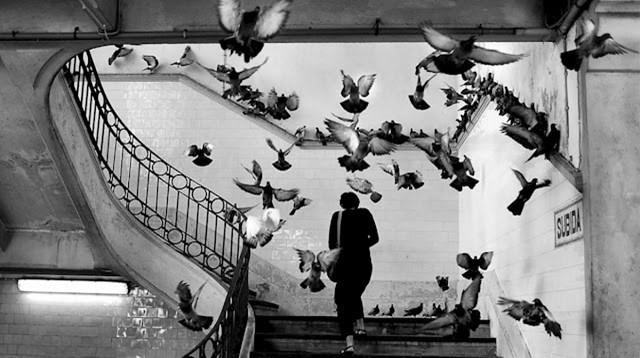In photography, the smallest thing can be a great subject. The little human detail can become a leitmotiv.— Henri Cartier-Bresson
“Constant new discoveries in chemistry
and optics are widening considerably our field of action. It is up to us to
apply them to our technique, to improve ourselves, but there is a whole group
of fetishes which have developed on the subject of technique. Technique is
important only insofar as you must master it in order to communicate what you
see... The camera for us is a tool, not a pretty mechanical toy. In the precise
functioning of the mechanical object perhaps there is an unconscious
compensation for the anxieties and uncertainties of daily endeavor. In any
case, people think far too much about techniques and not enough about seeing.” Henri
Cartier-Bresson on technical aspects of photography
By John William Tuohy
Henri Cartier-Bresson (August 22, 1908 –
August 3, 2004) was a French humanist photographer. Humanist Photography, also
known as the School of Humanist Photography, manifests the Enlightenment
philosophical system in social documentary practice based on a perception of
social change.
It emerged in the mid-twentieth-century
and is associated most strongly with Europe, particularly France, where the
upheavals of the two world wars originated, though it was a worldwide movement.
It can be distinguished from
photojournalism, with which it forms a sub-class of reportage, as it is
concerned more broadly with everyday human experience, to witness mannerisms
and customs, than with newsworthy events, though practitioners are conscious of
conveying particular conditions and social trends, often, but not exclusively,
concentrating on the underclasses or those disadvantaged by conflict, economic
hardship or prejudice. Humanist photography "affirms the idea of a
universal underlying human nature".
Jean Claude Gautrand describes humanist
photography as: a lyrical trend, warm, fervent, and responsive to the
sufferings of humanity [which] began to assert itself during the 1950s in
Europe, particularly in France ... photographers dreamed of a world of mutual
succor and compassion, encapsulated ideally in a solicitous vision.
Photographing on the street or in the
bistro primarily in black‐and‐white in available light with the popular
small cameras of the day, these image-makers discovered what the writer Pierre
Mac Orlan (1882-1970) called the 'fantastique social de la rue' (social
fantasticality of the street)and their style of image making rendered romantic
and poetic the way of life of ordinary European people, particularly in Paris.
Cartier-Bresson considered a master of candid
photography, and an early user of 35 mm film. He pioneered the genre of street
photography and viewed photography as capturing a decisive moment.
Cartier-Bresson was one of the founding
members of Magnum Photos in 1947. In the 1970s he took up drawing—he had
studied painting in the 1920s.
Although Cartier-Bresson became frustrated
with Lhote's "rule-laden" approach to art, the rigorous theoretical
training later helped him identify and resolve problems of artistic form and
composition in photography.
In the 1920s, schools of photographic
realism were popping up throughout Europe, but each had a different view on the
direction photography should take. The Surrealist movement, founded in 1924,
was a catalyst for this paradigm shift[vague]. Cartier-Bresson began
socializing with the Surrealists at the Café Cyrano, in the Place Blanche. He
met a number of the movement's leading protagonists and was drawn to the
Surrealist movement's technique of using the subconscious and the immediate to
influence their work.
Cartier-Bresson matured artistically in
this stormy cultural and political atmosphere. But, although he knew the
concepts, he couldn't express them; dissatisfied with his experiments, he
destroyed most of his early paintings.
Cartier-Bresson almost always used a
Leica 35 mm rangefinder camera fitted with a normal 50 mm lens, or occasionally
a wide-angle lens for landscapes. He often wrapped black tape around the
camera's chrome body to make it less conspicuous. With fast black and white
film and sharp lenses, he was able to photograph events unnoticed. No longer
bound by a 4×5 press camera or a medium format twin-lens reflex camera,
miniature-format cameras gave Cartier-Bresson what he called "the velvet
hand...the hawk's eye."
He never photographed with flash, a
practice he saw as "impolite...like coming to a concert with a pistol in
your hand."
He believed in composing his photographs
in the viewfinder, not in the darkroom. He showcased this belief by having
nearly all his photographs printed only at full-frame and completely free of
any cropping or other darkroom manipulation. He insisted that his prints be
left uncropped so as to include a few millimeters of the unexposed negative
around the image area, resulting in a black frame around the developed picture.
Cartier-Bresson worked exclusively in
black and white, other than a few unsuccessful attempts in color.
He started a tradition of testing new
camera lenses by taking photographs of ducks in urban parks. He never published
the images but referred to them as 'my only superstition' as he considered it a
'baptism' of the lens.
Cartier-Bresson is regarded as one of the
art world's most unassuming personalities. He disliked publicity and exhibited
a ferocious shyness since his days of hiding from the Nazis during World War
II. Although he took many famous portraits, his face was little known to the
world at large. This, presumably, helped allow him to work on the street
undisturbed. He denied that the term "art" applied to his
photographs. Instead, he thought that they were merely his gut reactions to
fleeting situations that he had happened upon.









